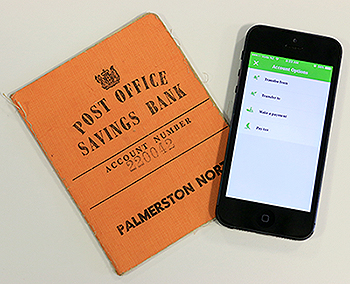Back in my day…
 In the afternoon, I would get the savings book back with the deposit amount and account balance handwritten in.
In the afternoon, I would get the savings book back with the deposit amount and account balance handwritten in.
A lot has changed since then. I can now do all my banking without ever visiting a bank branch by using online banking or an app on my cellphone. I can check my balance whenever I want, which also means my wife can see what I’ve put on the credit card as soon as I’ve used it! Technology is changing the way that services are being delivered, and with that comes a change in peoples’ expectations.
Organisations in both central and local government are trying to make it easier for people to access and use their services by making them more customer-centred. For example, there are two Better Public Services targets focused on improving peoples’ interaction with government. In most cases, this involves allowing people to access and use services online.
We’ve previously published some reports about how some public entities improved their services by putting them online, including Immigration New Zealand: Delivering transformational change, Inland Revenue Department: Governance of the Business Transformation programme, and Ministry of Health: Supporting the implementation of patient portals (my colleague Joy has written a blog post about this last report). These reports include some handy information for organisations to consider when planning to invest in information and technology systems to improve how they deliver services. We are also doing some further work on this topic.
Auckland Council is going through a similar transition to make it easier for customers to access and use its services online. The Council is doing this through something called the ‘Customer-centric Transformation Programme’ (now called the Digital and Transformation programme).
As part of our regular reviews of the Council’s service performance, we've published a report titled Auckland Council: Working to provide customer-centred services online. This report looks at the Council's programme and two projects under it: Identity Management, and the Licensing and Compliance Services Smart Forms project. The purpose of the Identity Management project was to make it possible for customers to sign in to all Council services using a single login account. Historically, each service was set up differently so customers had different accounts to carry out different tasks.
The aim of the Smart Forms project was to put 21 of the Council’s Licensing and Compliance Services forms and payments options online, including dog, alcohol, food, and street trading licenses, and health and hygiene certificates. The project also aimed to make the Council’s forms easier to understand and use.
We found that how the Council managed the projects was consistent with the some of the elements of good practice we identified in our report Realising benefits from six public sector technology projects. One of the things that I found interesting about the programme was its use of a co-design methodology. This meant that customers and Council staff were both involved in the design process for each service. For me, the difference is instead of using customers and Council staff to just identify problems, the Council also involved these two groups in creating solutions. The benefit of this approach is that the final service or product is more likely to meet the needs of users and be more user-friendly.
With the projects now delivered, customers can use a single login to access all of the Council’s online services. The process for services has also been simplified – making registering a dog or applying for a licence to run a business quicker and easier. A good example is dog registrations and renewals, of which the Council receives more than 80,000 each year. Before the programme, to register your furry best friend you would have to either visit one of Auckland Council’s service centres or mail in your registration form. Now, these can be completed and paid online.
This is just the start for Auckland Council. It has a whole series of projects that it is planning to complete over the next two years to make its services more customer-friendly for Aucklanders.
Do you have any examples where public entities have made it easier for you to use and access services? We’d like to hear about your experiences in the comments section below.
We also encourage you to provide feedback to your council or other public entities about any problems you have in using and accessing their services. Without your feedback, they might not know that people find it difficult to use and access their services.
